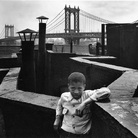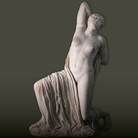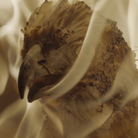Eliseo Mattiacci. Misurazioni

Eliseo Mattiacci, Dinamica a parete, 2010 ca., acciaio, bocce da gioco, cm. h 70x300 (diametro disco cm 45)
Dal 28 October 2017 al 24 February 2018
Firenze
Luogo: Galleria Poggiali
Indirizzo: via della Scala 29
Curatori: Lorenzo Bruni
Telefono per informazioni: +39 055 287748
E-Mail info: info@galleriapoggiali.com
Sito ufficiale: http://galleriapoggiali.com
La Galleria Poggiali di Firenze presenta sabato 28 ottobre 2017 dalle ore 18,00 la mostra personale di Eliseo Mattiacci dal titolo Misurazioni a cura di Lorenzo Bruni.
Il progetto di mostra nasce dalla volontà di osservare da un'angolazione inedita il percorso che Mattiacci ha sviluppato in più di cinquant'anni di lavoro. Con questo specifico scopo è stato scelto di far dialogare nella parte iniziale della Galleria Fiorentina due grandi sculture di anni differenti - Misurazione dei corpi celesti del 2003/2004 e Tempo globale del 1990/91 - assieme ad alcune opere su carta tra cui Opera nel bosco del 1983 e Occhio del cielo del 2005 che testimoniano la centralità della pratica del disegno nella sua produzione e poetica, oltre all'opera fotografica Rifarsi realizzata come unica traccia di una sua celebre performance del 1973. L'accostamento di tali opere permette di far emergere un motivo per la scultura inusuale quanto pregnante e che l'artista ha affrontato da angolazioni concettuali e soluzioni estetiche disparate: il manifestarsi del tempo da una parte e della temporalità dell'esperienza dall'altra.
Come scrive Lorenzo Bruni nel testo per il libro che sarà pubblicato appositamente per l'occasione: “La ricerca di Mattiacci può apparire ad uno sguardo superficiale come divisa in maniera netta tra le opere gestuali in dialogo con il corpo personale e sociale, con cui ha contribuito al dibattito dell'Arte Povera negli anni sessanta, e il periodo delle sculture dal tema cosmologico che formalizza dagli anni Novanta portando il dibattito attorno alla strategia dell'arte ambientale a soluzioni inaspettate. In realtà il percorso dell'artista si è sviluppato in maniera costante e coerente sempre all'insegna della domanda: quale è il ruolo che lo scultore può ricoprire nella riformulazione dell'etica culturale in una società in evoluzione e sempre più “liquida”? Tale questione concettuale, più che formale, lo ha portato a realizzare interventi che possono essere considerati in quanto tracce personali o istruzioni collettive della misurazione dell'attorno sia di quello visibile che invisibile.” Inoltre il curatore intende evidenziare che: Le sue installazioni esplorano da sempre i limiti e le potenzialità dello spazio architettonico e di quello naturale, delle strutture in ferro e delle tensioni magnetiche per puntare alla riformulazione dell'arte e della società con cui raggiungere un grado maggiore di consapevolezza del dialogo/confronto tra “io” e “mondo” e viceversa. Infatti, per lui visualizzare il cosmo come il corpo in quanto “presenze” è il passaggio necessario per dare concretezza e specificità all'entità che unifica e divide tutto: il tempo. Solo in questo modo può creare un meccanismo aperto con cui poter ripensare la posizione attiva dell'osservatore/artista su un piano differente che non sia semplicemente quello di voler ridurre tutto a una relazione di causa ed effetto, ma neanche di accettare l'impossibilità di spiegare i fenomeni che lo circonda.”
Le opere che caratterizzano i vari ambienti della Galleria, oltre alle sei precedentemente citate, puntano a sottolineare aspetti evanescenti del modo di fare arte di Mattiacci che sono emersi prepotentemente negli ultimi anni. Ad esempio interventi come Dinamica a parete del 2010 in acciaio e rame, Punti luce del 2011 in ottone e acciaio e i disegni con stili e soggetti differenti permettono di porre una nuova attenzione alla grande sensibilità pittorica e coloristica che da sempre caratterizza la sua indagine. Inoltre, la scultura Sospensione del 2011 – costituita da sei sfere in tondino di alluminio poste a terra – e Atomi e nuclei del 2010 – un piano di acciaio semicircolare che sostiene dei cilindri divisi a metà che contengono sfere in sospensione – evidenziano l'elemento fondamentale per la formalizzazione delle sue opere: concretizzare la tensione che può esistere tra le forze fisiche e visuali in contrasto/dialogo con il contenitore architettonico in cui vanno ad inserirsi trasformandolo, così, nello spazio dell'opera. Un ruolo centrale del progetto fiorentino è assunto dalla grande installazione dal titolo Corpo Celeste (meteorite) del 2008 che invadendo la galleria di via Benedetta modifica la relazione tra opera e spettatore indagando le potenzialità del monumento in un mondo post-ideologico. Il compito che l'artista gli affida in questo caso è quello di dare corpo ad una entità incommensurabile come quella del cosmo, intrecciandolo con il tema dell'archivio visto che la massa filiforme degli scarti della lavorazione del metallo assorbe o fa emergere dal suo nucleo centrale disegni incorniciati o frammentati di essi legati al tema dell'espansione o della dinamicità delle forme. L'orizzonte fisico e mentale, denso e delicato, che emerge dal percorrere opera dopo opera la mostra Misurazioni “permette di comprendere appieno la ricerca di Eliseo Mattiacci in quanto indagine e stimolazione dell'interazione che può esistere tra osservatore e paesaggio. Paesaggio, però, inteso come il risultato della negoziazione tra le coppie di opposti di: visibile e invisibile, architettonico e cosmologico, privato e collettivo”.
SCARICA IL COMUNICATO IN PDF
COMMENTI

-
 Dal 2 December 2025 al 19 February 2026
Milano | Centro Culturale di Milano
Dal 2 December 2025 al 19 February 2026
Milano | Centro Culturale di Milano
Walter Rosenblum. Il mondo e la tenerezza
-
 Dal 30 November 2025 al 12 April 2026
Gallarate | Museo MA*GA
Dal 30 November 2025 al 12 April 2026
Gallarate | Museo MA*GA
Kandinsky e l’Italia
-
 Dal 29 November 2025 al 12 April 2026
Roma | Musei Capitolini
Dal 29 November 2025 al 12 April 2026
Roma | Musei Capitolini
La Grecia a Roma
-
 Dal 22 November 2025 al 3 May 2026
Torino | Sale Chiablese dei Musei Reali
Dal 22 November 2025 al 3 May 2026
Torino | Sale Chiablese dei Musei Reali
Orazio Gentileschi. Un pittore in viaggio
-
 Dal 20 November 2025 al 25 January 2026
Firenze | Palazzo Strozzi
Dal 20 November 2025 al 25 January 2026
Firenze | Palazzo Strozzi
Andro Eradze. Bones of Tomorrow
-
 Dal 21 November 2025 al 28 March 2026
Cuneo | Complesso Monumentale di San Francesco
Dal 21 November 2025 al 28 March 2026
Cuneo | Complesso Monumentale di San Francesco
La Galleria Borghese. Da Raffaello a Bernini. Storia di una collezione


